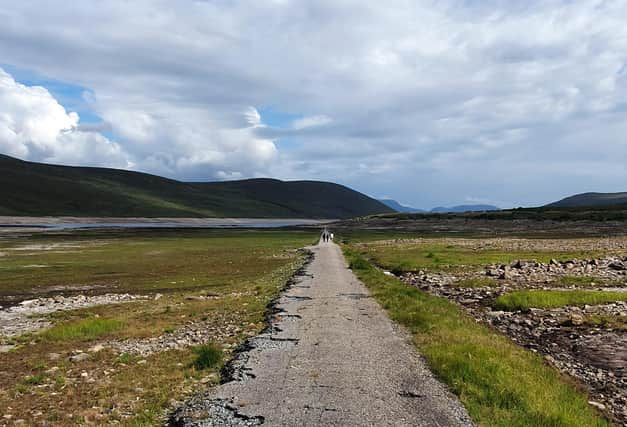Lost world emerges in the Highlands as water levels fall at loch


The features have emerged after Loch Glascarnoch, near Garve, dried out following the warm spell with water flow further reduced from a nearby dam to allow for maintenance.
The loch, which is essentially a man-made reservoir, opened in 1957 to service the Conon Hydro-Electric Power Scheme which brought “Power to the Glens’ and electricity to thousands of homes.
Advertisement
Hide AdAdvertisement
Hide AdThe loch was built over the old single-track road that ran through Glen Glascarnoch to Ullapool.
Now, the road along with the bridges and the outlines of old homes can be seen once again with the lost features drawing visitors to witness the landscape as it once was.
More than a mile of the old road can be seen, complete with passing places, with roots of old trees also visible.
Mark Campbell, of Maryburgh, just south of Dingwall, said: “The road has been flooded since the 1950s but in dry spells you can occasionally see it. This year though, the water
levels have been lower than normal and the bridges, ruined houses and lay-bys are a lot more visible. It felt nice and a little strange to be walking down that road which used to be active more than six decades ago.”
Dragos Floria, manager of Aultguish Inn, which sits at the head of the loch, said that water was now returning to the reservoir.
He said: “The water had almost disappeared but the levels are getting higher now as it has been coming from the dam over the past few days. There was a lot of grass and bits of wood around, it was very different to what is normally there.”
The old road was lost, and later replaced by the A835, after Parliament approved the hydro scheme in 1947 with Glascarnoch Glen damned and the loch created to hold water form Loch Vaich and Loch Droma before feeding into Mossford Power Station.
Advertisement
Hide AdAdvertisement
Hide AdA spokesman for SSE Renewables said: “SSE Renewables has been using a recent period of dry weather to carry out routine inspection and maintenance within the Conon hydro scheme.
“As a result of this we reduced the flow of water through Loch Glascarnoch to facilitate works, with a sustained low but normal water level in the loch.
“It is not unusual for reduced water levels in the loch, which occur as normal during periods of low rain or when maintenance and inspection works are being carried out within the
Conon hydro scheme, to reveal the old Dingwall to Ullapool road. With the anticipated rain fall in the coming days we expect that water levels in the loch will rise, submerging part, but not all, of the old road again.”
A message from the Editor:
Thank you for reading this story on our website. While I have your attention, I also have an important request to make of you.With the coronavirus lockdown having a major impact on many of our advertisers - and consequently the revenue we receive - we are more reliant than ever on you taking out a digital subscription.Subscribe to scotsman.com and enjoy unlimited access to Scottish news and information online and on our app. With a digital subscription, you can read more than 5 articles, see fewer ads, enjoy faster load times, and get access to exclusive newsletters and content. Visit https://www.scotsman.com/subscriptions now to sign up.
Our journalism costs money and we rely on advertising, print and digital revenues to help to support them. By supporting us, we are able to support you in providing trusted, fact-checked content for this website.
Joy Yates
Editorial Director